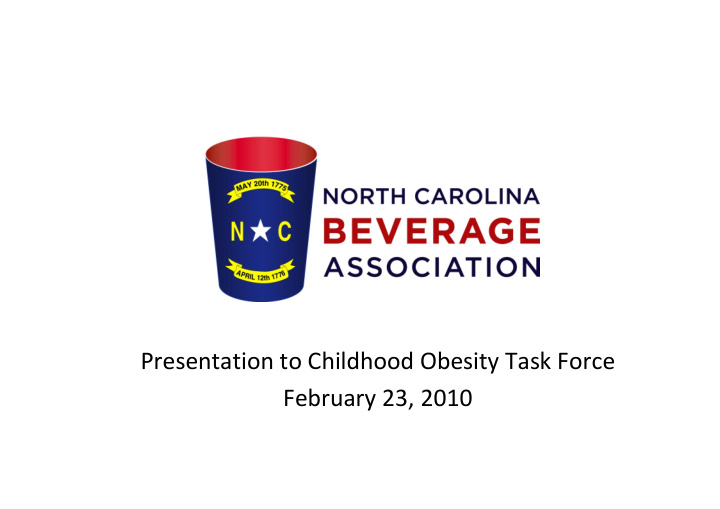



Presentation to Childhood Obesity Task Force February 23, 2010
North Carolina Beverage Association • The North Carolina Beverage Association is comprised of 17 companies that produce and distribute a wide range of non-alcoholic beverages. • Members include all of the Cola-Cola and Pepsi-Cola bottlers, and five independent bottlers.
NC Beverage Industry Led the Way 2003: North Carolina Health and Wellness Trust Fund • Study Committee on Childhood Obesity – Formed by Lt. Gov. Bev Perdue 2005: Committee recommends legislation to establish • a statewide standard for vended beverages and snack foods sold in public schools.
Statewide Standard for School Vending Senate Bill 961 / Session Law • 2005-253. – Sen. Purcell and Rep. Insko were primary sponsors. The NC Beverage Association • supported proposal and joined in efforts to pass the bill.
National Voluntary Commitment Emerges • Following NC‘s lead, in May of 2006... the American Beverage Association and its member companies teamed up with the Alliance for a Healthier Generation to develop new School Beverage Guidelines that limit calories and increase nutritious beverages in schools.
School Beverage Guidelines Summary • Reduce the number of calories children consume through beverages • Provide a broader range of lower- calorie and smaller portion beverage choices • Remove full calorie soft drinks from all schools
School Beverage Guidelines: Specifics Elementary School • Bottled water • Up to 8 ounce servings of milk and 100% juice • Low fat and non fat regular and flavored milk and nutritionally equivalent (per USDA) milk alternatives with up to 150 calories per 8oz. • 100% juice with no added sweeteners, up to 120 calories per 8oz., and with at least 10% DV of 3 or more vitamins and minerals
School Beverage Guidelines: Specifics Middle School • Same as elementary school except juice and milk can be sold in 10 oz. servings • As a practical matter, if middle school and high school students have shared access to areas on a common campus or in common buildings, then the school community has the right to adopt the higher standards.
School Beverage Guidelines: Specifics High School • Bottled water • No or low calorie beverages with up to 10 calories/8 oz. (e.g., diet soft drinks, teas, fitness waters, sports drinks) • Up to 12 oz. servings of milk, light juice, 100% juice • Low fat and no fat regular and flavored milk and nutritionally equivalent (per USDA) milk alternatives with up to 150 calories/8 oz. • 100% juice with no added sweeteners, up to 120 calories/8oz., and at least 10% DV of 3 or more vitamins and minerals • Other drinks with no more than 66 calories/8 oz.
School Beverage Guidelines www.schoolbeverages.com • At least 50% of beverages must be water and no- or low- calorie options Apply to beverages sold on school grounds during the • regular and extended school day. Do not apply to school-related events where parents and • other adults are part of an audience or are selling beverages as boosters before or after an event or during intermission (e.g., school plays, band concerts)
Making it Happen • Beverage companies have spent hundred of hours training their marketing and sales teams • These teams have reached out to educate school partners. • Our companies are reformulating products, creating new package sizes to meet the smaller portion requirements, and retrofitting vending machines to accommodate changes in package sizes.
Calories are coming out of schools. There was a 58% cut in total calories contained in all beverages shipped to schools between 2004 and the 2007-8 school year. The school beverage landscape is changing. There was a 65% reduction in shipments of full- calorie soft drinks to schools.
Key Points from School Beverage Guidelines Second Year Progress Report, cont. School agreements are on track. In the second year, 79% of all agreements between bottlers and school districts have achieved compliance with the guidelines, on track for the 3-year implementation plan. Stay Tuned. Final audited results should be announced next week.
ABA‘s Clear on Calories Initiative
Clear on Calories Initiative Implementation begins this year with completion in 2012 • Product labels: Total calorie counts will be displayed on the front of labels for the entire container, up to and including 20-ounce products. A 12-ounce serving size will be used in displaying calories for multi-serve beverage packages (such as 2-liter bottles). • Vending Machines: Total calorie counts for the entire container will be displayed on the beverage selection buttons of vending machines controlled by the companies. • Fountain Machines: Calorie counts will be shown prominently on fountain beverage machines controlled by the companies. be shown prominently on fountain beverage machines controlled by the companies.
Responsible Marketing International Council of Beverages Associations 2008 Agreement • Beverage companies voluntarily agree to eliminate the advertising and marketing of a wide range of beverages, including carbonated soft drinks, to any audience that is comprised predominantly of children under 12. • The policy applies to TV, radio, print, Internet, phone messaging and cinema (including product placement).
Responsible Marketing Third Party Audit Released in Nov. 2009 • Performed by Accenture • Extremely high compliance rates • Report Available online at the following link: http://www.icba- net.org/documents/ICBAComplianceReportonMarketingtoChildren.pdf
Thank you! Butch Gunnells President NC Beverage Association 919-828-2737 butch@ncbev.org
Recommend
More recommend